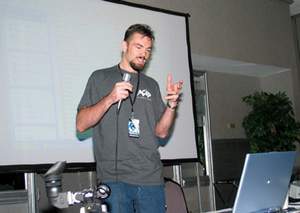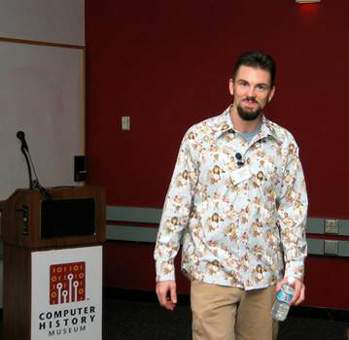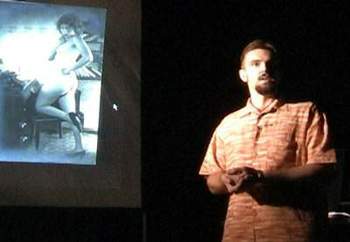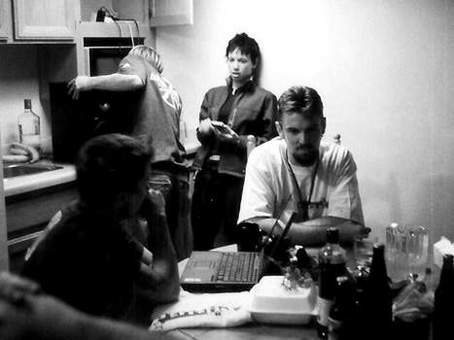; Aces of ANSi Art, or "Triple A" as they were called
hit the scene -- the underground scene -- and my eyes were really
opened. Here was this organized group of artists taking this method
of terminal control and using it in ways people had never before
imagined. They were pushing the envelope not just artistically by
using creative color combinations and unique character selections, but
also manipulating the X3.64 standard as a tool for animation. Aces
was quite certainly the first group of artists solely dedicated to the
advancement of the BBSing experience, and they focused right in on the
underground scene. It's been commonly said that throughout the BBSing
era of the 1990s you could easily distinguish the elite BBSes from the
commonplace, open-access, "public domain" ones within the first few
seconds of logging on. The elite boards always had the best ANSI
graphics. I suppose you could say from the moment they [Aces of ANSi
Art] got started I was hooked.
JASHIIN:
Have you ever followed the artscene that existed in the demoscene
(pixel art that later evolved into hirez; artists such as Facet,
Visualice, Lazur, Made, Saffron, et cetera.)? If so, what is your
opinion of it?
RAD MAN:
Yes, of course. I've always been a huge fan of the European demoscene
and the illustrious pixel artists which have emerged from it. In fact,
ACiD has had quite a few pixel artists in our group, some of which are
world renowned. Saffron, for example, was an active member of our
group from 1997-1999.
All the names you've mentioned are highly talented and well-known
superstars far beyond their own circles, and rightfully so. You can
really draw a good number of parallels between the pixel graphicians
and the ANSI artists of the past:
For example, the nature of how things are drawn -- one block (or
pixel) at a time -- or that both routinely made use of outside
sources as points of reference. In the pixel scene, graphicians drew
from legendary fantasy artists such as Boris Vallejo, Frank Frazetta,
Hajime Sorayama, or borrowed from a multitude of pin-up mags. On the
other hand you have the ANSI scene which frequently refers to the
work of modern comic book artists like Todd McFarlane, Jim Lee, Carlos
Pacheco, and of course Jack Kirby. Both ANSI and pixel scene artists
alike selected similar subjects to copy from; well endowed and scantily
clad females or superheroes and villains with enormously muscular and
chiseled physiques. In both spheres the legitimacy of copying as an
art form is a hotly debated topic, just referred to by different
adjectives; "no-copy" versus "copy" and "original" versus "comic rip"
-- it all boils down to the same thing; artists taking a limited
resolution, limited palette and performing the delicate task of acting
as a human digitizer.
JASHIIN:
How did pHluid start, where did the musicians stem from?
Protocol and Pinion were relatively unknowns in the music scene, but
their names and music were mentioned in TraxWeekly for instance. So
were they just random musicians who happened to use trackers or what?
RAD MAN:
I would have to respectfully disagree with you regarding the unknown
comments. Pinion's tracks were distributed far and wide across BBSes
both before and during his tenure in ACiD. But first let me rewind
and take you two years further back -- back to 1992.
The first signs of life within ACiD musically was when local PC scener
Piano Man left the Digital Noise Alliance (DNA) to join up with us in
1992. As a result, our group began to expand in new directions and
attract more talented musicians, but there was just one small problem.
The music scene was exploding, our musical artists were producing at a
pace faster than our coders could utilize, and we typically only
distributed tracked songs as part of a larger EXEcutable loader rather
than singly.
Now fast forward back to late 1994 -- Pinion, who was a very good
friend of the amazing ANSI artist Somms, recognized the needs of our
musicians and stepped forward to found what is now known as the pHluid
sublabel. He oversaw the ambitious production of our very first music
disk which was released June 3rd, 1995 (ph-0695.zip) and many more
thereafter. Pinion continues to release tracks with ACiD (as recent
as this year's ACiD-100) and provides invaluable support to the rest
of the group.
 Protocol was also a staunch contributor to what eventually led up to
formation of pHluid. While he was not so much engaged in the typical
social scene outlets such as IRC he was an extremely valuable member
who was heavily involved in the day-to-day activities of both pHluid
and ACiD. Eventually he became successor to the throne after Pinion
stepped down as lead Advisor in 1997. Those from the school of old
will recall that Protocol was one of few musicians to be featured on
both the audio and data side of the first demoscene CD-ROM; a mixed-
mode disc titled "Escape" which featured the winning songs from Music
Contest 2 (MC2).
Protocol was also a staunch contributor to what eventually led up to
formation of pHluid. While he was not so much engaged in the typical
social scene outlets such as IRC he was an extremely valuable member
who was heavily involved in the day-to-day activities of both pHluid
and ACiD. Eventually he became successor to the throne after Pinion
stepped down as lead Advisor in 1997. Those from the school of old
will recall that Protocol was one of few musicians to be featured on
both the audio and data side of the first demoscene CD-ROM; a mixed-
mode disc titled "Escape" which featured the winning songs from Music
Contest 2 (MC2).
JASHIIN:
What was your opinion about HRg packs in 1998? Because from Russian
e-magazines from that era one could infer that HRg was serious
competition for ACiD. Was this true?
RAD MAN:
HRg was yet another excellent group which I think changed the
perception of what was acceptable subject matter within the scene and
helped further shape what you can trace forward as the hirez scene
movement, eventually leading to the art groups that you see on more
aboveground sites like deviantART today. They reasserted the notion
that scene art can have a deeper meaning; it doesn't just have to be
just more of the same blatant in-your-face eye candy.
Shortly after HRg disbanded, many of the core members enlisted with us
as we held similar values as they did and were already headed in the
same general direction to begin with. I never once really considered
them "serious competition", but rather allies in part of a much larger
movement. As I wrote in one of my ACiD European Reunion announcements,
at the close of 2003 over 75% of our hirez division resided either
somewhere in Europe or Russia. I'm very proud to have been a part of
the same group as them.
JASHIIN:
Last year you said you thought Crasher's art was amazing, and generally
expressed an encouraging attitude towards his stuff. Could you comment
on that?
RAD MAN:
Crasher is good because he's not just creating "shit" and calling it
"abstract art". He is a talented artist who grasps the ASCII medium
well and can effectively translate that into abstract art. At the same
time he has created some very amazing newschool pieces that have a very
three dimensional feel to them that easily rival some of Computer Man's
best work.

Past Projects...
JASHIIN:
About the projects ACiD has developed; how did the most popular screen
editor ever, ACiDDraw, happen? And why didn't it support ANSImation?
RAD MAN:
ACiDDraw was the brainchild of one person, Skull Leader, who joined us
by way of the GOTHiC merger which shook up the scene in April of 1994.
Although not an artist himself, Skull Leader had a passion for the
textmode arts and wanted to remedy what he saw as the shortcomings the
existing set of screen editors had to offer. Under the span of 4
months he had introduced a working beta of ACiDDraw (0.1b) which
offered such pioneering features as internal VGA-mode viewing and
editing of screens up to 80x800-lines long, (extended to 1000-lines in
later versions). Prior to its release, real-time VGA-mode viewing was
virtually unheard of, and leading editors only supported ANSIs up to
80x100 lines long. That's not to say that there wasn't 100+ line
long ANSI artwork before hand; there was. In order to accomplish such
a thing one would have to draw in 80x100 line "tiles", if you will,
and then quite literally copy them all together.
Even the masters of ANSI made mistakes on occasion when performing
this task. Evidence of this can be seen in the amazing 300-line work
created by Alter Ego entitled "On Top in 1994" (ACDU0294.ZIP,
ae-vudu.ans). If you look closely, you will notice an over-estimation
was made right below the 100-line mark when joining the first and
second parts.
As for ANSImation, ACiDDraw didn't support it because it wasn't
necessary. Until the very end, all of our active ANSI animation
artists continued to use the rock-solid version of TheDraw 3.30 for
saving purposes, and pulled from version 4.6x for their excellent
suite of animation effects and screen transitions. We didn't see any
sense in reinventing the wheel since TheDraw fulfilled our needs as
an ANSImation tool.
JASHIIN:
Why do you think X-Bin never got the recognition it deserved, or did
it?
RAD MAN:
XBIN probably would have been much more successful had it been
delivered two years earlier. We didn't unveil it until the second
quarter of '96, and then one year later we exited the ANSI game
completely.
The number one strongest attribute about XBIN is that it gives control
back to the artist. It empowers them to specify precisely how the
viewer will ultimately see their work. Rather than have to ask the
question "Please use AFS.COM" or "Best viewed in 80x50 mode" at the
top of their piece, they can simply embed the exact character set they
used while drawing the art and that is what the viewer will see. You
could include anything from a customized character set, Russian code
page, or even a PETscii or Amiga Topaz font.
You don't necessarily have to go down to the extremely granular level
of editing each individual character, modifying the palette, and
tweaking out the height settings in order to take advantage of XBIN.
It's a great standard, and all things considered I think that the
recognition it's received has been fair.
JASHIIN:
Why did it take until 2003 for a Microsoft Windows version of ACiD
View to surface?
RAD MAN:
Well, that's not entirely true. :) Although not widely circulated,
the very first Windows version of ACiD View was released by SiDS in
1995. It was more of a proof-of-concept more than anything really,
but it worked. Eventually he lost interest in the project and we
began to shift our focus on Java technologies; starting with a simple
applet that could view ANSI online via our ACiD Artpacks Archive which
in turn led to the release of MrKite's ACiD View Java, or ACiD View
version 5 as the successor to our DOS-based version.
Ultimately, we ditched the Java version and the development of art
viewers altogether. Then, in 2003, gz had contacted us regarding this
ANSI viewer he was writing for Windows. Realizing his commitment to
the scene and this application, we brought him into ACiD and provided
him with the support he needed to help make the viewer the success it
is today.
Current Projects...
JASHIIN:
When did the thought about ACiD-100 first cross your mind? Did you
actually expect to reach 100 packs back in, say... 1994?
RAD MAN:
I'm not sure what I would have said had I been asked in 1994. But by
the time we were at the release of ACID-50 in '96, serious thoughts
about our hundredth Acquisition Update were already crossing my mind.
Project planning and a truly concerted effort did not begin however
until August '02.
JASHIIN:
The memberlist on the ACiD-100 page lists more than 700 (721 to be
correct!) people. How many of those were actually contacted, and how
many of those who you contacted took part in the project? How did
people react to the fact that ACiD is still alive and releasing?
RAD MAN:
Yes, that is correct. Although I've "retired" from my leadership
responsibilities in ACiD, the group continues to grow by way of our
extended family members in Remorse and pHluid. The group now stands
at 730 members.
Prior to the time of ACiD-100's release, 421 of the 721 (58.39%) had
been personally notified. Approximately a quarter of those contacted
took part by contributing artwork, music or textfiles for the upcoming
Product 3 magazine.
Reactions of ACiD still being existing varied, depending heavily upon
which year they dropped out of the scene (if at all). For example,
anyone contacted after 1996 had the general attitude of "Of course ACiD
is still alive! It's a scene institution!" On the other hand, some of
the earlier members who quit before say '92 or '93 just assumed that
ACiD must have dropped off when the internet "took over" and didn't
give it a second thought. Overall, everyone was very enthusiastic to
hear that we were achieving such a milestone, and it was a lot of fun
to relive so many old memories and catch up with so many different
folks.
JASHIIN:
How does it feel to release 100th pack, especially knowing your group
is the first (and possibly the last) to release that many packs?
RAD MAN:
It is very satisfying to know that ACiD made it that far but it should
be recognized though that we're not alone. iCE too has released 100
artpacks, although they no longer observe the traditional pack format,
now only releasing their "packs" as on-line galleries.
JASHIIN:
The same thing about The ARTS. When did the idea of a radio talk show
first cross your mind? How successful was the first broadcast?
RAD MAN:
The ARTS concept first came to mind in February of this year while I
was taking a road trip across country from California to Missouri, with
various detours along the way to visit ACiD members such as Catbones,
Adya, Funky Muskrat and Tank. While driving through certain states you
are sometimes given two options for music; Tejano, Gospel, or some other
religious variant of music. I can only take so much of either, so I
plugged in my iRock FM transmitter to my laptop and fired up Winamp.
Taking a cue from Jason Scott, I had already downloaded a bunch of other
talk shows; most noteworthy being RFA (Radio FreeK America) and BinRev
(Binary Revolution), both of which are hack/phreak oriented programs.
After listening to a few dozen episodes along the way, I was rather
inspired by the concept and decided something of this sort would be
perfect for our scene. I had plenty of time to come up with the
obligatory acronym since I had a total distance of 4,894 miles to travel.
Oddly enough I came up with the acronym while driving back through
New Mexico. (I'll leave it to the readers to determine where the
coincidence in that lies.)
When I returned from my trip I called up Spinsane to explain what I had
in mind, and he was on board one hundred percent. The first show was
completely off the cuff without absolutely any preparation made before
recording. Still, we managed to feature some great interviews with
Basehead of #trax, Steeler speaking live at BP'04, and Pyro of Beyond,
all sharing some very enlightening nuggets of scene history. I really
couldn't have been happier with the outcome.
JASHIIN:
Could you tell about how its done? Do you actually do real-time
broadcasting or is it all pre-recorded?
RAD MAN:
The ARTS is recorded "live" much in the same manner that a televised
late show is recorded live. There are certain instances where we may
pre-record a piece; for example if it is impossible for Spinsane and I
to sync up our schedule with someone we'd like to interview, we'll tape
it in advance and then add it in later during post production. There
are certain parts which are edited out obviously, such as when we call
a guest, we blank out their phone number following the area code.
Other than that, our recording setup is very basic. After testing
several different hardware configurations, including two made
specifically for line-taps, we ultimately opted for the simple ghetto
hack used by RFA and BinRev; a microphone and a speakerphone. We upped
the ante slightly by using a decent mic connected via XLR to an ART
(Applied Research and Technology) Pro Tube Mic Preamp, providing a much
richer and warmer sound than you'd receive from a standard computer
microphone. I also tested several different speakerphone brands until I
was satisfied with both the sound and duplexing abilities of the Uniden
PowerMax 5.8GHz base station. Before each show we exchange final show
notes and run down a quick checklist of things including equipment tests
and sound checks. The rest is, well, history.
JASHIIN:
How did you become involved with this whole Pilgrimage thing? How
much work goes into organizing the competitions?
RAD MAN:
Everything about Pilgrimage 2003 demoparty thoroughly impressed me;
the positive feedback from the attendees, the concert by Nullsleep,
the amazing invite demo by xplsv -- and the winning DC-5 demo k-wak
could have placed first at any party.
Then Legalize wrote up a great article for Static Line 47,
"Organizing a US Demo Party" which really convinced me that I need to
be a part of this. Something was happening; scene giants across
North America were finally reawakening. Legalize and I exchanged
emails for several months and then ultimately I volunteered to make a
commitment to Pilgrimage and took on the role as Compo Organizer.
As with any new responsibility, you immediately gain a new found form
of respect for anyone that has ever held a similar role. As part of
the organizing team I promote the sanctioned competitions, publish the
rules and build partnerships with outside vendors to make prizes
possible, et cetera. This year we have calculated over $13,500 in
cash and prizes will be awarded to competitors and guests, with
two additional sponsors pending.

The Scene...
JASHIIN:
Since the magazine I'm interviewing you for already had a number of
articles dealing with "defining the scene", "the scene is in you" and
"the scene is dead" type attitudes, I feel obliged to ask you about
your outlook on the artscene.
What is your attitude towards statements like "the scene is dead"?
RAD MAN:
Those type of ridiculous assertations have been made since I can
remember. Typically they're made by people who slowly recognize that
the scene is changing and mistake it as "death". Change is not death.
It's the opposite, the turning of a new leaf. Besides, the scene is
so great that it can not be defined by any one person. Therefore, how
can someone ever say that it has died? It's the spirit that matters
anyhow, and the spirit of the scene transcends any hardware platform.
The only time the scene will be dead is when there is no one left to
say that it is.
JASHIIN:
Before I ask the final question... Do you have any serious interests
not connected to computers? Like "what is your attitude towards art in
general, i.e. painting or wire frame installations?", "can you actually
cook and do you regard cooking as an art?" Those kinds of questions.
RAD MAN:
Which question do you want to ask? :)
My passion is in computer-based art but yes, I believe art can be found
in everything. There is an art to coding, cooking, fighting...
Anything.
In the offline world, my interests are in cooking, running and of
course being with my family.
JASHIIN:
What do you think about this "digital art" phenomena some people are
raving about? Do you seriously think there is a need for a completely
digital artform? Are you, like those people, fascinated with digital
technology to the degree of considering it to be the future of art?
RAD MAN:
Curators are finally beginning to take to digital art -- specifically
demos and ASCII art -- referring to it as "new media" art. That's a
bit of a misnomer because we all know that digital art has been going
on for decades now what with synthesized music and vocals in the 1960s
and 3D models in the 1970s. Prior to art made up of the ASCII
character set, remote teletype operators transmitted text-based
artwork in the 1920s using a code set called Baudot. Amazingly enough,
this 5-bit code dates back to 1874. You can continue to trace this
sort of evidence of both history repeating itself and the events that
led up to them forever.
Digital forms of art have advantages and challenges that go somewhat
hand in hand. We're fortunate in that we can create perfect, lossless
digital copies of our work, yet we are constantly at battle with the
relatively short lifecycle that the hardware and software which our
work is displayed with depends upon. Emulators such as WinUAE, VICE
and DOSbox and viewers like ACiD View and PabloView have helped
prolong the lifespan of many great digital works, but little things
inevitably get lost in the translation.
Anyone will tell you that in order to view a certain demo or similar
piece of work you need the precise platform it was coded for. You
must have a 486DX2 with Gravis soundcard, an Amiga 1200, or a
PAL-capable Commodore 64. But the simple fact is that this is not a
reality for most of us. There needs to be a "Real-time Museum"
displaying the greatest demos on original hardware.
The time has come.
Editor's Note
RaD Man's "100 Years of the Computer Art Scene" presentation,
originally delivered in cooperation with Jason Scott, deals with many
of the topics discussed in this interview. It is available in audio
format, along with transcript, on the ACiD website at:
http://www.acid.org/images/notacon04/.
Reprinted with permission, Tsifra (Digit) Magazine - http://tsifra.spb.ru
Jashiin
 ACiD was the legend of the 1990s, the biggest and the most powerful
artgroup which pretty much defined scene standards in textmode and
high resolution art with both their artpacks and their side projects
(including, but not limited to, the most popular textmode editor ever,
ACiDDraw, and the highly acclaimed ACiD View for Windows). Random
lamers would now argue that their influence doesn't really exist in
the scene anymore, since the textmode artscene is virtually
non-existent while all the hirez artists drifted towards commercial
jobs... The point is; if you've never seen ACiD's artpacks -- if
names like Somms, Lord Jazz, Necromancer or Catbones don't sound
familiar to you then you don't have the slightest idea what the scene,
or scene-spirit, or whatever those oldschool people all around those
half-dead artscene channels are always talking about -- you don't
have the slightest idea about what it is.
ACiD was the legend of the 1990s, the biggest and the most powerful
artgroup which pretty much defined scene standards in textmode and
high resolution art with both their artpacks and their side projects
(including, but not limited to, the most popular textmode editor ever,
ACiDDraw, and the highly acclaimed ACiD View for Windows). Random
lamers would now argue that their influence doesn't really exist in
the scene anymore, since the textmode artscene is virtually
non-existent while all the hirez artists drifted towards commercial
jobs... The point is; if you've never seen ACiD's artpacks -- if
names like Somms, Lord Jazz, Necromancer or Catbones don't sound
familiar to you then you don't have the slightest idea what the scene,
or scene-spirit, or whatever those oldschool people all around those
half-dead artscene channels are always talking about -- you don't
have the slightest idea about what it is.

 Protocol was also a staunch contributor to what eventually led up to
formation of pHluid. While he was not so much engaged in the typical
social scene outlets such as IRC he was an extremely valuable member
who was heavily involved in the day-to-day activities of both pHluid
and ACiD. Eventually he became successor to the throne after Pinion
stepped down as lead Advisor in 1997. Those from the school of old
will recall that Protocol was one of few musicians to be featured on
both the audio and data side of the first demoscene CD-ROM; a mixed-
mode disc titled "Escape" which featured the winning songs from Music
Contest 2 (MC2).
Protocol was also a staunch contributor to what eventually led up to
formation of pHluid. While he was not so much engaged in the typical
social scene outlets such as IRC he was an extremely valuable member
who was heavily involved in the day-to-day activities of both pHluid
and ACiD. Eventually he became successor to the throne after Pinion
stepped down as lead Advisor in 1997. Those from the school of old
will recall that Protocol was one of few musicians to be featured on
both the audio and data side of the first demoscene CD-ROM; a mixed-
mode disc titled "Escape" which featured the winning songs from Music
Contest 2 (MC2).

